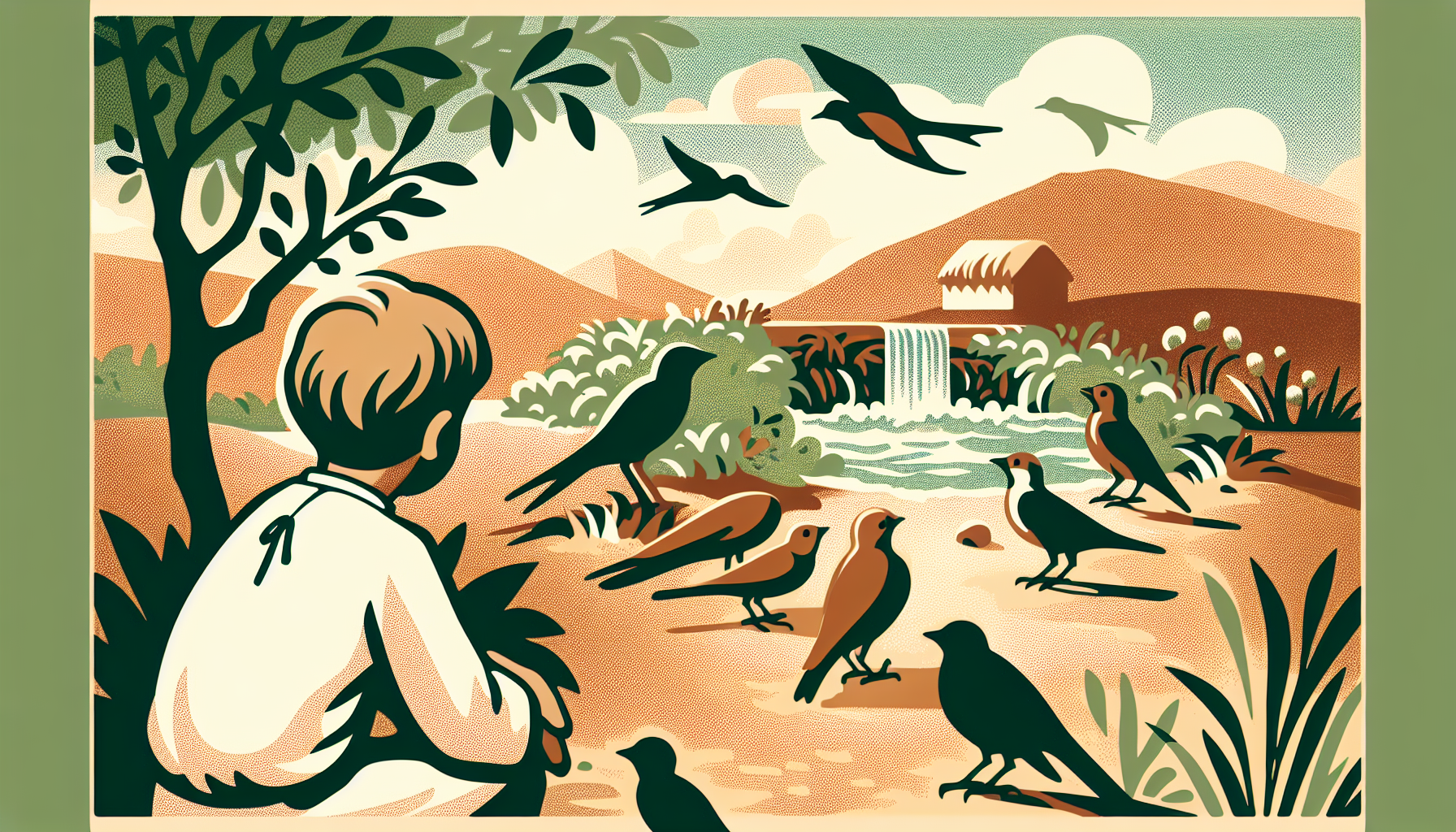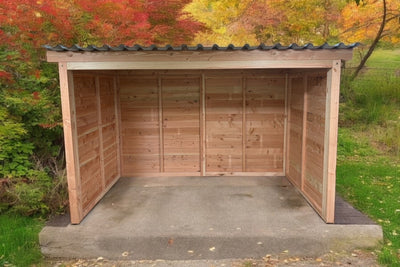Build your own bird bath: How to promote biodiversity in the garden
A living garden is more than just beautifully designed beds and green lawns - it is a small ecosystem. Many garden owners in Switzerland are looking for simple ways to make their outdoor space more ecological and family-friendly. A bird bath fulfills exactly this purpose: if you want to build a bird bath yourself, you can support garden birds in hot summers and frosty weather while at the same time bringing more life, movement and observation opportunities into the garden. Being close to birds slows you down, promotes biodiversity and makes your own garden more resilient to extreme weather conditions. In Switzerland, periods of heat are increasing, which is why regular sources of water in urban areas are becoming more important. With a well thought-out DIY project, you can create a natural eye-catcher that is robust, safe and easy to maintain - ideal for families, rental gardens and homes at all altitudes.
At the same time, a bird bath offers families with children the chance to discover nature up close and develop ecological awareness. Construction does not have to be complicated or expensive. With the right materials, a suitable location and a little skill, a simple project can become a long-term benefit for you, your family and the wildlife.
In this article, you will learn about the benefits of a bird bath, which materials are recommended, how to plan and practically implement the construction and what you should look out for in terms of care and safety. We also give an honest assessment of the costs - including tips for a small budget. Let's get started!
What are the advantages of a bird bath in the garden?

More and more people in Switzerland want to actively contribute to biodiversity in their gardens. A bird bath is an effective way to support birds - and if you want to build your own bird bath, you can promote biodiversity right on your doorstep. The Federal Office for the Environment also provides tips on ecological garden design, highlighting urban areas as an important habitat. bafu.admin.ch
1.1 Promoting biodiversity
Sources of drinking water are becoming scarcer for wild birds - especially during hot summers and frosty winters. With a shallow, easily accessible bowl, you provide an important watering place for drinking and bathing. This improves plumage care, health and vitality.
At the same time, you attract different species, from sparrows and tits to blackbirds and robins. More birds mean natural pest control and a more stable garden ecosystem. The Swiss Ornithological Institute offers practical tips for a bird-friendly garden. vogelwarte.ch
Periods of heat are on the increase, especially in cities. If you build your own bird bath and fill it regularly, you can help birds during dry spells and make your garden more attractive. MeteoSwiss provides recommendations on what to do in hot weather. meteoswitzerland.admin.ch
1.2 Observation opportunities for children and families
It is fascinating for children to observe animals in their environment. A daily mini-safari at the water bowl will spark questions, stimulate nature diaries and strengthen a sense of responsibility when children help clean up.
Adults benefit too: Birdwatching slows you down and creates short breaks in everyday life. If you build and cleverly place a bird bath yourself, you can experience garden life up close - at any time of year.
Which materials are suitable for building a bird bath?
When choosing materials, environmental aspects and weather resistance are important - especially in the Swiss climate with frost, strong temperature fluctuations and intense sun. If you want to build a bird bath yourself, choose non-toxic, durable materials without problematic coatings.
2.1 Sustainable choice of materials: Wood, stone or ceramic
Natural materials are recommended for a durable and ecological solution. These are particularly suitable:
- Stone or slate: Withstands heat and frost, is easy to clean and very stable. Ideal for permanently installed drinking troughs in the floor area.
- Ceramic or terracotta: Look out for frost-resistant versions. Untreated ceramic is free of harmful substances and easy to clean. Search query: Bird bath material ceramic frost-resistant.
- Wood: Great for stands or frames. Use weatherproof Swiss wood species such as larch or Douglas fir and low-maintenance, non-toxic wood oils.
Upcycling also makes sense: an old clay bowl, a soup plate or even a baking tray can be transformed into a functional bird bath with little effort. This saves costs and resources.
2.2 Weatherproof materials for Swiss weather conditions
Robust, break-proof and UV-resistant components are particularly worthwhile at higher altitudes or where there are large differences between day and night. Glass is unsuitable for outdoor use as it breaks easily. Plastic deforms, bleaches out and can release microplastics.
If you prefer metal, choose stainless steel. Galvanized steel heats up quickly in the sun and can crack in winter. For anyone who builds their own bird bath, the following applies: quality pays off with durability and easy maintenance.
How do I plan the ideal bird bath for my garden?
Before you get started, it's worth planning carefully. Size, depth and space depend on the garden layout and safety aspects. If you want to build a bird bath yourself, you should also consider the water connection and maintenance requirements.
3.1 Choice of location: Sun, shade and safety for birds
The ideal location is semi-shady so that the water does not overheat or evaporate too quickly. A spot with morning or evening sun is often ideal and reduces algae growth.
Choose a clear position at least two to three meters away from hedges. This way, birds have enemies in view and cats cannot sneak up unnoticed. Many people are looking for a specific solution: bird bath height to prevent cats from sneaking in.
A raised drinking trough is difficult for ground hunters to reach. If you want to build a bird bath yourself and think about child safety, position it stably, non-slip and not directly in play areas.
3.2 Size and depth of the drinking trough: child safety and practical implementation
A shallow bowl with a water depth of three to five centimetres is sufficient for garden birds. Birds cannot swim, so a shallow depth is important.
For children and insects, shallow edges or an inlaid stone increase safety. Make sure the drinking trough is easy to reach and easy to clean - ideally near a garden hose.
What steps are necessary to build a bird bath yourself?
With a little planning, the right tools and robust materials, even beginners can succeed. If you want to build a bird bath yourself, the project can easily be completed as a weekend task or together with children.
4.1 Helpful tools and utensils
The tools required depend on the material. For a simple version on a wooden frame, you will usually need
- Drill or cordless screwdriver
- Saw for woodwork
- Sandpaper or random orbital sander for smooth edges
- Screws, angle irons or wooden dowels
- Wood oil or weatherproof protective glaze without harmful substances
A robust clay bowl or frost-resistant ceramic is often sufficient for the water vessel. Only check the drillability of stable materials, otherwise it is better to fix them in a clamped or surface-mounted manner.
4.2 Step-by-step instructions for construction
Variant: Bird bath on wooden pillar with clay bowl
- Choose a sturdy wooden pillar made of larch wood, approx. 80-100 cm high, from the DIY store or as scrap wood from the carpenter.
- Sand surfaces and corners carefully to avoid splinters.
- Treat the wood with plant-friendly wood oil; suitable products are available locally, e.g. from Landi.
- Attach a circle of non-slip rubber or silicone to the top so that the bowl rests securely.
- Place a clay bowl with a diameter of 20-30 cm and a maximum depth of five centimetres in the middle.
- Fill it with fresh water and place a flat stone or a shard of clay in it. This makes it easier to sit and serves as an exit aid.
Alternatively, hanging models with macramé suspension or floor models with a mortar tray are suitable. It is important that the construction is not prone to tipping over, that it is stable and that you are happy to look after it - this will ensure that you continue to enjoy building your own bird bath.
How do I look after my bird bath properly and avoid common mistakes?
A bird bath is only as good as its care. Stagnant water quickly turns into a germ trap. If you want to build a bird bath yourself and use it for a long time, you need to clean it regularly and place it in a shady, well-ventilated area.
5.1 Regular cleaning and water changes
Ideally, you should clean it daily in midsummer and weekly in moderate weather. Use a brush and clear water. Vinegar or baking soda can help with deposits, then rinse thoroughly. Many people specifically search for bird bath cleaning with vinegar - use it sparingly and rinse thoroughly.
In winter, changing the water every two to three days is usually sufficient. Avoid salt or antifreeze. For a frost-free bird bath in winter, lukewarm water in the morning helps; heated models are rarely necessary and increase the maintenance effort.
5.2 Safety for children and pets during use
Plan to prevent tipping and avoid containers that are too deep, especially near play areas. An elevated position makes it difficult for cats to access and protects the birds.
If cats or dogs live in the household, place the drinker in an elevated and clearly visible position. Regular cleaning reduces the risk of germs and keeps the water quality stable - an advantage if you build the bird bath yourself and adapt it to your routine.
What should I bear in mind when it comes to costs?
A DIY project should not become a cost trap. If you want to build a bird bath yourself, you can save a lot with existing materials. Sustainable, robust solutions pay off with a longer service life and less maintenance.
6.1 Realistic cost estimate for materials and construction
For a sturdy model with a wooden pillar and clay bowl, calculate - depending on quality and source of supply - with:
- Wooden column or scrap material: CHF 10-20
- Clay bowl or ceramic vessel: CHF 10-30
- Screws, oil, seals: CHF 5-10
This means that the total cost is usually between CHF 25-60. If you upcycle, for example with an old kitchen bowl or natural stone, you can reduce your costs even further and remain flexible in terms of design.
6.2 Long-term savings through quality and durability
A high-quality bird bath will last five to ten years or longer if well cared for. Avoiding cheap plastic solutions saves resources and avoids follow-up costs due to breakage or replacement.
In addition, the experience value of your garden increases: more species observations, fewer pests and a harmonious overall picture. BirdLife shows how water points can increase the number of species in the garden - a plus point if you build the bird bath yourself and integrate it into a nature-oriented concept. birdlife.ch
Conclusion: Small measure - big effect
A self-built bird bath is more than just decoration: it creates habitat, improves the garden ecology and offers your family daily moments in nature. If you build your own bird bath, place it wisely and maintain it consistently, you will make your garden fit for heat, drought and changeable CH weather conditions.
Start now: Check materials, choose a location, fill the first bowl - and watch the feathered guests. You can find more nature-oriented ideas for your garden at the Swiss Ornithological Institute and BirdLife. Start your garden project now and make your own green space more biodiverse step by step.


